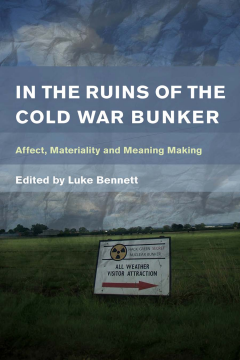
Additional Information
Book Details
Abstract
During the Cold War military and civil defence bunkers were an evocative materialisation of deadly military stand-off. They were also a symbol of a deeply affective, pervasive anxiety about the prospect of world-destroying nuclear war. But following the sudden fall of the Berlin Wall in 1989 these sites were swiftly abandoned, and exposed to both material and semantic ruination.
This volume investigates the uses and meanings now projected onto these seeming blank, derelict spaces. It explores how engagements with bunker ruins provide fertile ground for the study of improvised meaning making, place-attachment, hobby practices, social materiality and trauma studies. With its commentators ranging across the arts and humanities and the social sciences, this multi-disciplinary collection sets a concern with the phenomenological qualities of these places as contemporary ruins – and of their strange affective affordances – alongside scholarship examining how these places embody, and/or otherwise connect with their Cold War originations and purpose both materially and through memory and trauma.
Each contribution reflexively considers the process of engaging with these places – and whether via the archive or direct sensory immersion. In doing so the book broadens the bunker’s contemporary signification and contributes to theoretically informed analysis of ruination, place attachment, meaning making, and material culture.
Provocative and informative yet personal and thoughtful, this diverse collection of essays offers a much needed exploration of that defining cultural space of the 20th century – the bunker. Bennett and his collaborators approach the ruins of the Cold War not just as historical curiosities but as the starting point for a myriad of trans-disciplinary journeys and adventures.
Ian Klinke, Associate Professor in Human Geography at the University of Oxford and the author of the forthcoming monograph Cryptic Concrete: A Subterranean Journey to Cold War Germany.
With its extensive and authoritative inquiry into the entire field of ruins, the Cold War bunker, and of its affect, materiality, and meaning the world over, Luke Bennett’s In the Ruins of the Cold War Bunker is an essential source book for anyone interested in the Cold War bunker as motive, memorial, or munition.
John Armitage, Professor, Winchester School of Art, University of Southampton
Luke Bennett has brought together international research on real and imagined Cold War bunkers. Readers are introduced to the bunker and Cold War histories through an enchanting mix of chapters that attend to the bunker’s stubborn materiality, visual representation and the visceral experiences they invite. This book should be read by anyone – scholars, curators, and enthusiasts included – interested in what ‘ruins’ mean in the 21st century.
Hilary Geoghegan, Associate Professor in Human Geography, University of Reading
An intriguing and absorbing set of journeys into some of the formerly secret spaces of the Cold War. In the footsteps of MacFarlane, Sebald and Virilio, and forging their own paths, the contributors lead us from Norway to Albania and from the United States to Taiwan. An essential complement to contemporary work on the vertical spaces above ground.
Stuart Elden, Professor of Political Theory and Geography, University of Warwick
Luke Bennett is Reader in Space, Place & Law in the Department of the Natural and Built Environment at Sheffield Hallam University, UK.
A captivating account of the multifaceted ways in which bunkers, the most iconic of Cold War spaces, are rendered meaningful by various “communities of practice” in the 21st century. By its interdisciplinary approach, global reach and emphasis on material-affective agencies, the book breaks new ground - and made me realize that in one way or another, the now abandoned structures have traumatized us all and will always be alive.
Dr. Silvia Berger Ziauddin, Assistant Professor, University of Zurich and author of forthcoming monograph Survival Cell, Territory, Brothel: The Bunker in Cold War Switzerland and Beyond
Table of Contents
| Section Title | Page | Action | Price |
|---|---|---|---|
| In the Ruins of the\r\nCold War Bunker | Cover | ||
| Contents | v | ||
| Figures and Table | vii | ||
| Acknowledgements | xi | ||
| Part I: Introducing the bunker: Ruins, hunters and motives | 1 | ||
| 1 Approaching the Bunker: Exploring the Cold War through Its Ruins | 3 | ||
| 2 Entering the Bunker with Paul Virilio: The Atlantic Wall, Pure War and Trauma | 23 | ||
| Part II: Looking at the bunker: Representation, image and affect | 39 | ||
| 3 Peripheral Artefacts: Drawing [Out] the Cold War | 41 | ||
| 4 Sublime Concrete: The Fantasy Bunker, Explored | 57 | ||
| 5 Processual Engagements: Sebaldian Pilgrimages to Orford Ness | 75 | ||
| Part III: Embracing the bunker: Identity, materiality and memory | 95 | ||
| 6 Torås Fort: A Speculative Study of War Architecture in the Landscape | 97 | ||
| 7 Bunker and Cave Counterpoint: Exploring Underground Cold War Landscapes in Greenbrier County, West Virginia | 113 | ||
| 8 Recuperative Materialities: The Kinmen Tunnel Music Festival | 131 | ||
| 9 Once upon a Time in Ksamil: Communist and Post-Communist Biographies of Mushroom-Shaped Bunkers in Albania | 145 | ||
| Part IV: Dealing with the bunker: Hunting, Visiting and Re-making | 165 | ||
| 10 Popular Historical Geographies of the Cold War: Hunting, Recording and Playing with Small Munitions Bunkers in Germany | 167 | ||
| 11 ‘A Nice Day Out?’: Exploring Heritage (and) Tourism Discourses at Cold War Bunker Sites in Britain | 185 | ||
| 12 Preserving and Managing York Cold War Bunker: Authenticity, Curation and the Visitor Experience | 201 | ||
| 13 Atoombunker Arnhem: An Architect’s New Uses for Old Bunkers | 215 | ||
| Part V: Conclusion | 231 | ||
| 14 Presencing the Bunker: Past, Present and Future | 233 | ||
| Index | 251 | ||
| Contributors | 265 |
